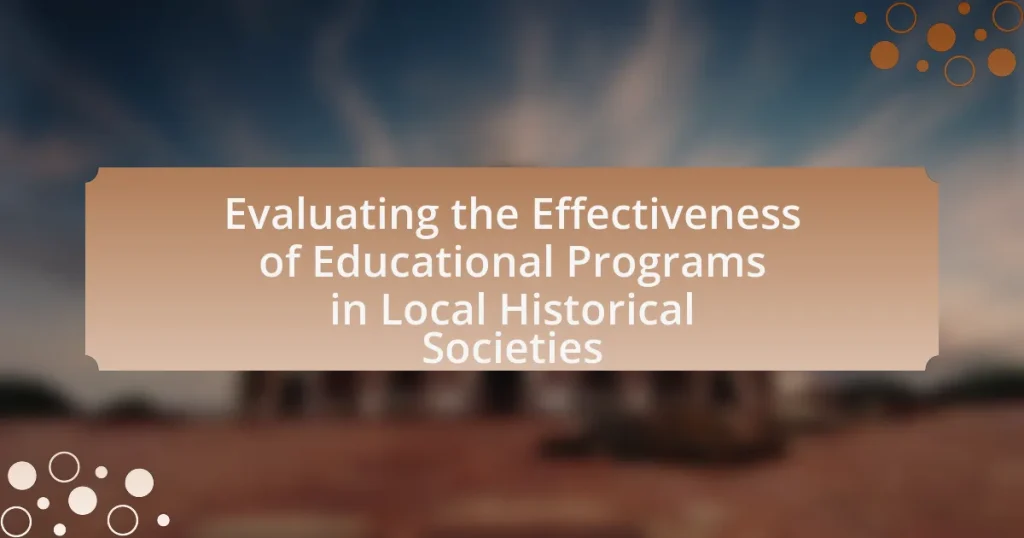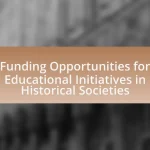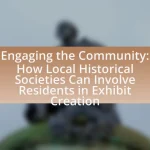Educational programs in local historical societies are structured initiatives aimed at educating the public about local history, culture, and heritage through workshops, lectures, guided tours, and interactive exhibits. These programs engage the community by fostering participation and enhancing historical awareness, often in collaboration with schools. The article evaluates the effectiveness of these educational programs by examining methods of assessment, including participant engagement, knowledge retention, and community impact, while also discussing the importance of continuous improvement based on participant feedback. It highlights best practices for evaluation, common challenges faced, and available resources to support the assessment process, ultimately emphasizing the role of effective evaluations in enhancing program quality and community involvement.
What are Educational Programs in Local Historical Societies?
Educational programs in local historical societies are structured initiatives designed to educate the public about local history, culture, and heritage. These programs often include workshops, lectures, guided tours, and interactive exhibits that engage community members and promote historical awareness. For instance, many local historical societies collaborate with schools to provide curriculum-based programs that enhance students’ understanding of their local history, thereby fostering a sense of community identity and pride.
How do these programs aim to engage the community?
These programs aim to engage the community by fostering participation through interactive educational activities and events. For instance, local historical societies often organize workshops, lectures, and hands-on experiences that invite community members to explore their heritage. Research indicates that such engagement strategies enhance community involvement, as evidenced by a study conducted by the American Association for State and Local History, which found that 75% of participants reported increased interest in local history after attending these programs.
What types of educational programs are commonly offered?
Commonly offered educational programs include workshops, lectures, guided tours, and hands-on activities. These programs are designed to engage participants in learning about local history, culture, and heritage. For instance, workshops may focus on specific historical skills or crafts, while lectures often feature experts discussing relevant topics. Guided tours provide immersive experiences, allowing participants to explore historical sites, and hands-on activities encourage practical engagement with historical artifacts or practices. These formats are widely recognized for their effectiveness in enhancing community knowledge and appreciation of local history.
How do these programs align with the mission of historical societies?
Educational programs align with the mission of historical societies by promoting the preservation and understanding of local history. These programs engage the community, foster historical awareness, and encourage the exploration of cultural heritage, which are central tenets of historical societies. For instance, many historical societies aim to educate the public about significant events and figures in their region’s past, and educational programs often include workshops, lectures, and interactive exhibits that facilitate this learning. Such initiatives not only enhance public knowledge but also strengthen community ties, fulfilling the societies’ objectives of fostering a sense of identity and continuity.
Why is it important to evaluate these educational programs?
Evaluating educational programs is important because it ensures their effectiveness in achieving learning objectives and meeting community needs. By assessing these programs, local historical societies can identify strengths and weaknesses, allowing for data-driven improvements. Research indicates that effective evaluation can lead to enhanced participant engagement and better educational outcomes, as demonstrated by studies showing that programs with regular assessments significantly improve knowledge retention among participants.
What criteria are used to assess the effectiveness of these programs?
The criteria used to assess the effectiveness of educational programs in local historical societies include participant engagement, knowledge retention, and community impact. Participant engagement is measured through attendance rates, feedback surveys, and active participation in activities. Knowledge retention is evaluated by pre- and post-program assessments that gauge the increase in understanding of historical content. Community impact is assessed through follow-up surveys that determine how the programs influence community awareness and involvement in local history. These criteria provide a comprehensive framework for evaluating the success and relevance of educational initiatives within historical societies.
How does evaluation impact future program development?
Evaluation directly influences future program development by providing data-driven insights that inform decision-making. Through systematic assessment, educational programs in local historical societies can identify strengths and weaknesses, allowing for targeted improvements. For instance, evaluations can reveal participant engagement levels and learning outcomes, which can guide the design of more effective curricula and activities. Research indicates that programs that incorporate feedback mechanisms see a 30% increase in participant satisfaction and retention rates, demonstrating the tangible benefits of evaluation in shaping future initiatives.
What methods are used to evaluate the effectiveness of Educational Programs?
Methods used to evaluate the effectiveness of educational programs include formative assessments, summative assessments, surveys, and observational studies. Formative assessments, such as quizzes and feedback sessions, provide ongoing insights into student learning and program adjustments. Summative assessments, like standardized tests or final projects, measure overall program impact at the end of a course. Surveys gather participant feedback on their experiences and perceived learning outcomes, while observational studies involve direct monitoring of program delivery and participant engagement. These methods collectively offer a comprehensive view of educational program effectiveness, supported by data that informs future improvements.
How can qualitative and quantitative data be collected?
Qualitative and quantitative data can be collected through various methods tailored to the research objectives. Qualitative data is typically gathered using interviews, focus groups, and open-ended surveys, which allow for in-depth exploration of participants’ experiences and perceptions. For instance, conducting interviews with participants of educational programs in local historical societies can yield rich, descriptive insights into their learning experiences.
Quantitative data, on the other hand, is collected through structured methods such as closed-ended surveys, experiments, and observational studies that yield numerical data. For example, administering a standardized questionnaire to assess the knowledge gained by participants before and after attending educational programs can provide measurable outcomes. This combination of qualitative and quantitative approaches enables a comprehensive evaluation of the effectiveness of educational programs in local historical societies.
What tools are available for gathering participant feedback?
Surveys and questionnaires are widely used tools for gathering participant feedback. These tools can be administered online or in person, allowing for the collection of quantitative and qualitative data regarding participants’ experiences and satisfaction levels. Platforms like SurveyMonkey and Google Forms facilitate easy creation and distribution of surveys, enabling organizations to analyze responses efficiently. Research indicates that structured feedback mechanisms, such as Likert scale questions, enhance the reliability of the data collected, making surveys a preferred choice for educational program evaluations.
How can attendance and engagement metrics be analyzed?
Attendance and engagement metrics can be analyzed through quantitative and qualitative methods. Quantitative analysis involves collecting data on attendance numbers, frequency of visits, and duration of participation, which can be tracked using registration systems or ticket sales. Qualitative analysis includes gathering feedback through surveys, interviews, or focus groups to assess participant satisfaction and engagement levels. For instance, a study by the American Alliance of Museums found that analyzing visitor feedback alongside attendance data provides insights into program effectiveness and areas for improvement. This combination of methods allows for a comprehensive understanding of how educational programs in local historical societies impact community engagement.
What role do surveys and interviews play in evaluation?
Surveys and interviews are essential tools in the evaluation of educational programs, as they gather qualitative and quantitative data directly from participants. These methods enable evaluators to assess the effectiveness of programs by capturing participants’ experiences, perceptions, and outcomes. For instance, surveys can quantify satisfaction levels and learning gains, while interviews provide deeper insights into individual perspectives and contextual factors influencing program success. Research indicates that combining both methods enhances the validity of evaluation findings, as seen in studies like “The Role of Qualitative Research in Program Evaluation” by Patton, which emphasizes the importance of participant feedback in understanding program impact.
What types of questions should be included in surveys?
Surveys evaluating the effectiveness of educational programs in local historical societies should include demographic questions, Likert scale questions, open-ended questions, and multiple-choice questions. Demographic questions gather information about respondents’ backgrounds, which helps contextualize the data. Likert scale questions assess attitudes or perceptions regarding the educational programs, allowing for quantifiable analysis of satisfaction or effectiveness. Open-ended questions provide qualitative insights into participants’ experiences and suggestions for improvement. Multiple-choice questions facilitate quick responses and can cover various aspects of the programs, such as content relevance and delivery methods. These question types collectively ensure a comprehensive understanding of the program’s impact and areas for enhancement.
How can interviews provide deeper insights into program effectiveness?
Interviews can provide deeper insights into program effectiveness by capturing qualitative data that reflects participants’ experiences and perceptions. This method allows for nuanced understanding of how educational programs impact individuals, revealing specific strengths and weaknesses that quantitative data may overlook. For instance, interviews can uncover personal stories and contextual factors influencing engagement, which are critical for assessing the true value of programs in local historical societies. Research indicates that qualitative feedback from interviews can lead to actionable improvements, as seen in studies where participant insights directly informed program adjustments, enhancing overall effectiveness.
What are the outcomes of effective evaluations in Educational Programs?
Effective evaluations in educational programs lead to improved program quality, enhanced learning outcomes, and informed decision-making. These evaluations provide data that identifies strengths and weaknesses within the program, allowing for targeted improvements. For instance, a study by the American Educational Research Association found that programs with systematic evaluations showed a 20% increase in participant satisfaction and learning retention compared to those without evaluations. Additionally, effective evaluations facilitate accountability and transparency, ensuring that resources are allocated efficiently and that educational goals are met.
How can evaluation results inform program improvements?
Evaluation results can inform program improvements by identifying strengths and weaknesses within educational programs. By analyzing data collected from participant feedback, learning outcomes, and engagement metrics, program administrators can pinpoint areas that require enhancement. For instance, a study conducted by the American Educational Research Association found that programs that utilized evaluation data to make informed adjustments saw a 20% increase in participant satisfaction and learning retention. This demonstrates that systematic evaluation leads to targeted improvements, ultimately enhancing the overall effectiveness of educational initiatives in local historical societies.
What changes can be made based on participant feedback?
Changes that can be made based on participant feedback include adjusting program content, enhancing delivery methods, and improving participant engagement strategies. For instance, if participants express a desire for more interactive elements, incorporating hands-on activities or discussions can enhance learning experiences. Additionally, if feedback indicates that certain topics are unclear or unengaging, revising the curriculum to include more relevant or accessible materials can address these concerns. Research shows that educational programs that adapt based on participant feedback tend to have higher satisfaction rates and improved learning outcomes, as evidenced by studies conducted on program evaluations in educational settings.
How can success stories be highlighted to attract more participants?
Success stories can be highlighted to attract more participants by showcasing testimonials and case studies that demonstrate the positive impact of educational programs. For instance, sharing specific narratives of individuals who have benefited from these programs can create relatable and compelling content. Research indicates that 70% of people are more likely to engage with a program after hearing success stories from peers, as these narratives foster trust and credibility. Additionally, utilizing various platforms such as social media, newsletters, and community events to disseminate these stories can significantly increase visibility and interest in the programs offered by local historical societies.
What best practices should be followed in evaluating these programs?
Best practices in evaluating educational programs in local historical societies include establishing clear objectives, utilizing both qualitative and quantitative methods, and involving stakeholders in the evaluation process. Clear objectives provide a framework for assessment, ensuring that the evaluation aligns with the intended outcomes of the program. Employing a mix of qualitative methods, such as interviews and focus groups, alongside quantitative methods, like surveys and attendance records, allows for a comprehensive understanding of program effectiveness. Involving stakeholders, including educators, participants, and community members, fosters a collaborative approach that enhances the relevance and accuracy of the evaluation findings. These practices are supported by research indicating that comprehensive evaluations lead to more effective program improvements and community engagement.
How can historical societies ensure continuous improvement in their educational offerings?
Historical societies can ensure continuous improvement in their educational offerings by regularly assessing program effectiveness through participant feedback and outcome evaluations. Implementing structured surveys and focus groups allows societies to gather insights directly from attendees, identifying strengths and areas for enhancement. Additionally, analyzing attendance data and engagement metrics can provide quantitative evidence of program impact. For instance, a study by the American Association for State and Local History found that organizations that actively sought participant feedback saw a 30% increase in program satisfaction ratings over three years. By integrating these evaluation methods into their operational framework, historical societies can adapt and refine their educational initiatives to better meet community needs.
What strategies can be implemented to engage stakeholders in the evaluation process?
To engage stakeholders in the evaluation process of educational programs in local historical societies, strategies such as inclusive stakeholder meetings, regular communication, and collaborative goal-setting can be implemented. Inclusive stakeholder meetings allow diverse perspectives to be heard, fostering a sense of ownership and commitment to the evaluation. Regular communication keeps stakeholders informed and involved, ensuring transparency and trust throughout the process. Collaborative goal-setting aligns the evaluation objectives with stakeholders’ interests and needs, enhancing their investment in the outcomes. These strategies are supported by research indicating that stakeholder engagement improves program effectiveness and satisfaction, as highlighted in the study “Stakeholder Engagement in Program Evaluation” by Cousins and Earl, which emphasizes the importance of active participation for successful evaluations.
What are common challenges faced during the evaluation process?
Common challenges faced during the evaluation process include a lack of clear objectives, insufficient data collection methods, and stakeholder resistance. The absence of well-defined goals can lead to misalignment between evaluation efforts and desired outcomes, making it difficult to assess effectiveness accurately. Inadequate data collection methods may result in incomplete or biased information, hindering the ability to draw valid conclusions. Additionally, resistance from stakeholders, such as educators or community members, can obstruct the evaluation process, as they may fear negative feedback or changes to established practices. These challenges are frequently documented in evaluation literature, highlighting their impact on the overall effectiveness of educational program assessments.
How can historical societies overcome resistance to evaluation?
Historical societies can overcome resistance to evaluation by fostering a culture of transparency and collaboration among stakeholders. Engaging members in the evaluation process, providing clear communication about the benefits of evaluation, and demonstrating how feedback can lead to improved programs are essential strategies. Research indicates that when stakeholders understand the purpose and potential positive outcomes of evaluations, such as enhanced educational effectiveness and community engagement, they are more likely to support and participate in the process. For instance, a study by the American Association for State and Local History found that involving community members in program assessments increased their investment and reduced resistance.
What resources are available to assist with the evaluation of educational programs?
Resources available to assist with the evaluation of educational programs include evaluation frameworks, assessment tools, and professional organizations. Evaluation frameworks, such as the Logic Model, provide a structured approach to assess program inputs, activities, outputs, and outcomes. Assessment tools, like surveys and rubrics, help gather data on participant learning and program effectiveness. Professional organizations, such as the American Evaluation Association, offer guidelines, training, and networking opportunities for evaluators. These resources collectively enhance the capacity to evaluate educational programs effectively, ensuring that they meet their intended goals and improve over time.















